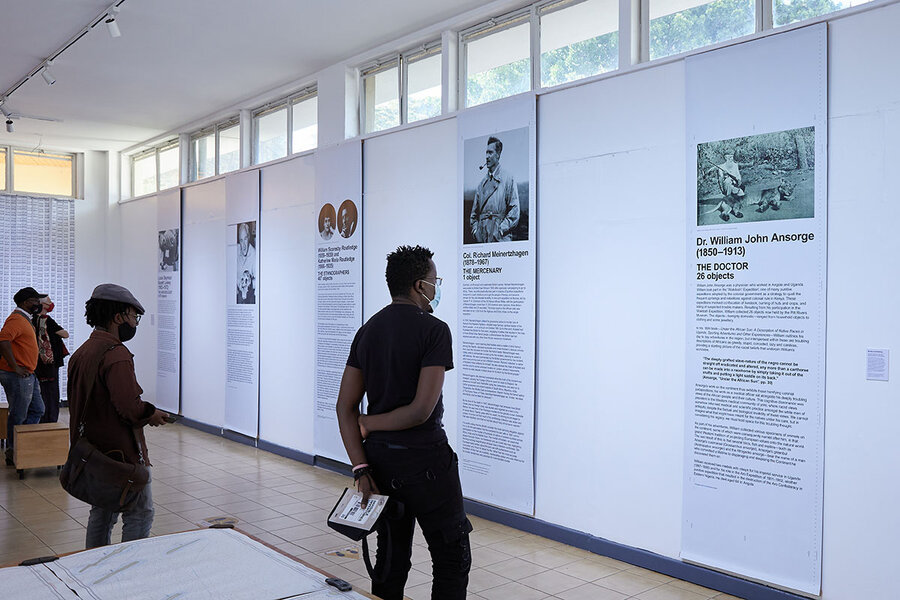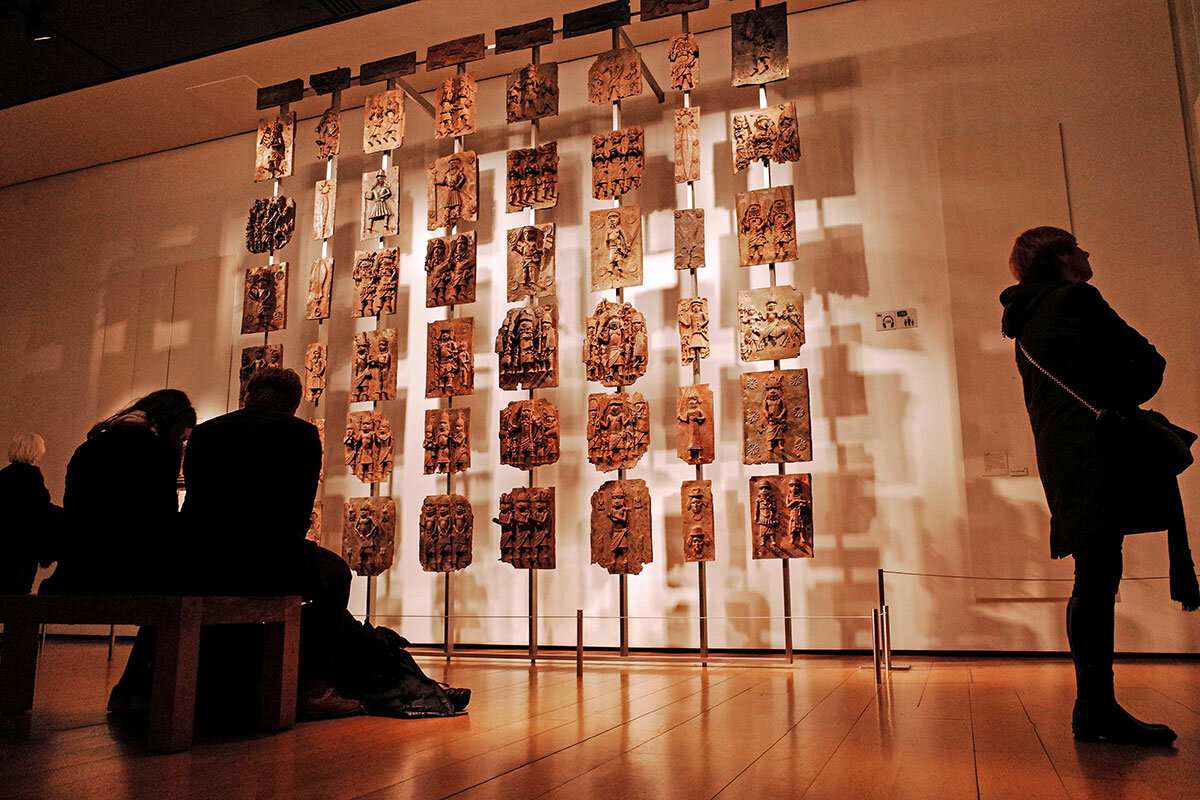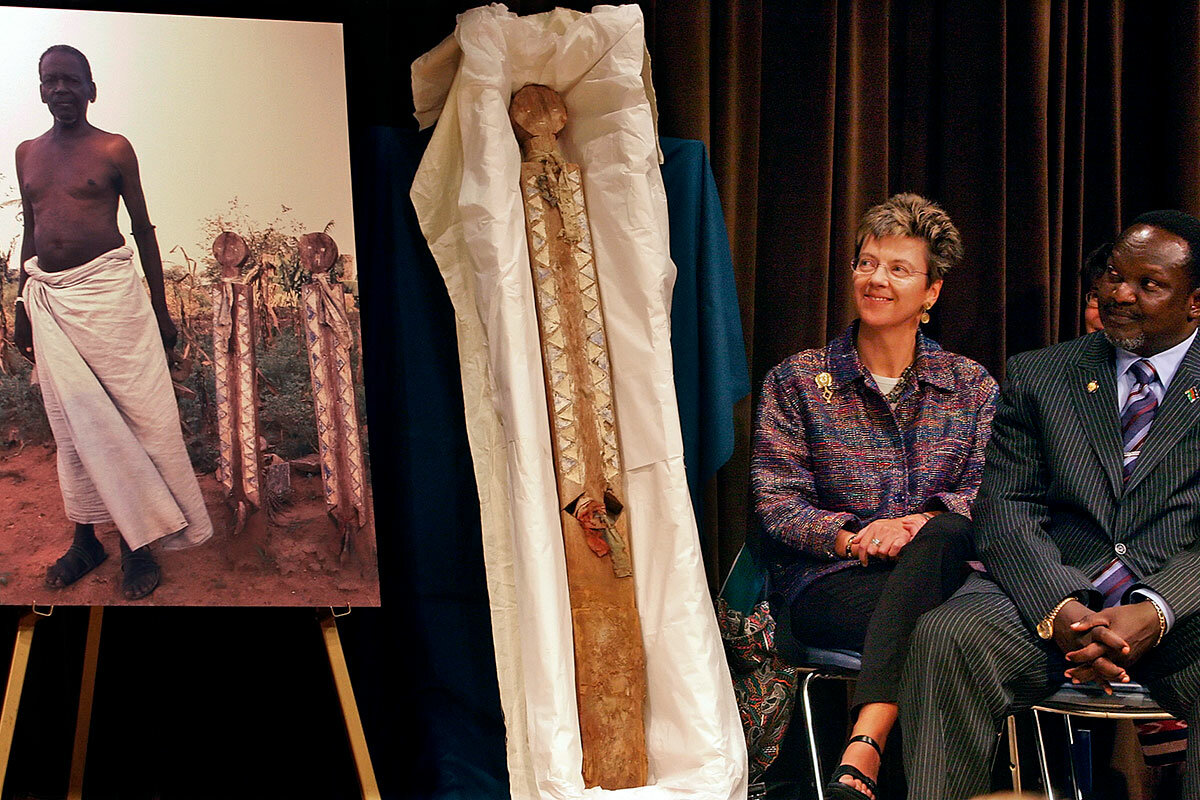Why a Kenyan art exhibit spotlights empty cases
Loading...
In a display hall at the Nairobi National Museum is a piece made up of 2,000 shipping labels. Each one bears data about an object taken from present-day Kenya by Europeans during the colonial period, many of them stolen. But the name of the piece is “31,302”: the number of Kenyan pieces held in European and American institutions, as cataloged by the International Inventories Programme, a Kenyan-European collective.
The collective put together this exhibition, called “Invisible Inventories,” to highlight the tens of thousands of objects plundered from Africa, and examine the legacies of that loss – the holes it has left behind in communities robbed of their heritage.
Why We Wrote This
When you walk into a museum, you don’t expect empty cases. But in this exhibit, you do – and that’s the point. It honors the visceral loss of heritage in countries whose art was plundered during the colonial era.
“Watching people interact with this exhibition, we’re seeing the anger and the pain,” says Jim Chuchu, director of The Nest, an artists’ collective that co-organized the exhibit. Many Kenyans, he says, have never seen this history of dispossession “put on the record.”
The debate about who should be the custodians of Africa’s art and artifacts stretches back more than half a century. But the movement for restitution has garnered renewed momentum.
“The movement is snowballing,” says Souleymane Bachir Diagne, a Senegalese philosopher and professor at Columbia University. “There’s a public pressure now that wasn’t there before.”
In a display hall at the Nairobi National Museum, a row of glass cases at the center of a new exhibition sits empty.
That’s by design. They display an absence, representing the tens of thousands of objects taken out of present-day Kenya by Europeans during the colonial period – many of them stolen. At least 32,000 of those pieces, including works of art and other pieces of great cultural significance, remain in museums in the Western world, according to a database compiled by the International Inventories Programme (IIP), a collective of Kenyan and European scholars, archivists, and artists.
The group put together this exhibition, called “Invisible Inventories,” to examine what that empty space means – the holes it has left behind in communities and countries robbed of their heritage.
Why We Wrote This
When you walk into a museum, you don’t expect empty cases. But in this exhibit, you do – and that’s the point. It honors the visceral loss of heritage in countries whose art was plundered during the colonial era.
“For us, these missing objects are just the beginning,” says Njoki Ngumi, a member of The Nest, a Nairobi-based artists’ collective that co-organized the exhibition. “They are a symbol of something much larger.”
The debate about who should be the custodians of Africa’s art and artifacts – the countries and communities that produced it, or the Western institutions where as much as 95% of it resides – stretches back more than a half-century, to the era of African independence.
But the movement for restitution of African art has garnered renewed momentum in recent years. In 2018, a report by Senegalese economist Felwine Sarr and French historian Bénédicte Savoy, and commissioned by the French presidency, recommended that France begin repatriating items it had taken without consent during colonial rule. Germany, meanwhile, set up a government office to assist with repatriation, and several European museums have pledged to return their collections of Benin Bronzes, iconic brass sculptures plundered from the Kingdom of Benin in modern-day Nigeria.
“The movement is snowballing,” says Souleymane Bachir Diagne, a Senegalese philosopher and professor of French at Columbia University, who advised Dr. Sarr and Dr. Savoy on their report. “There’s a public pressure now that wasn’t there before.”
But even as conversations and negotiations continue, the absence is still viscerally felt, say the organizers of “Invisible Inventories.”
“Watching people interact with this exhibition, we’re seeing the anger and the pain,” says Jim Chuchu, The Nest’s director. Many Kenyans, he says, have never seen this history of dispossession “put on the record. So this exhibition goes some way to telling people their feelings of loss are valid. It’s OK to feel wronged.”
The empty glass cases form only a small part of the exhibition, which also features works by a wide variety of Kenyan and European artists addressing the legacies of the loss.
One piece, for instance, is made up of thousands of shipping labels strung together, each bearing data about a Kenyan artifact currently held overseas.
The title of that piece, “31,302,” comes from the number of Kenyan pieces held in about 30 European and American institutions that the IIP had cataloged by the time “Invisible Inventories” opened in mid-March. It’s a way, Mr. Chuchu says, of visualizing “each and every object” – except that so many objects were identified that only the labels for around 2,000 could be displayed.
Elsewhere in the exhibition are panels with descriptions and photos of six “objects of national importance” – all of them Kenyan cultural pieces held by overseas museums. They include the Ngadji, a sacred drum of the Pokomo people stolen by a Norwegian wood trader. The drum is held by the British Museum, where it has sat in storage for more than a century, never once put on display.
“The loss that’s been experienced is much larger than just these objects – it’s about a loss of value systems, of history,” says Sam Hopkins, a member of the Shift Collective, a group of European artists involved in the exhibition. “So it’s not just about giving back the objects and saying we’re all square. It’s much more complicated than that.”
After its run in Nairobi, “Invisible Inventories” will be displayed in two museums in Germany, where its organizers hope it will continue to inspire visitors to think about larger questions of loss and redress related to colonialism.
“Colonialism created a global system based on injustice and inequality – how do you right that?” Mr. Hopkins says. “But if you can return objects to communities that need and miss those objects, that’s a clear step and it’s a start.”











